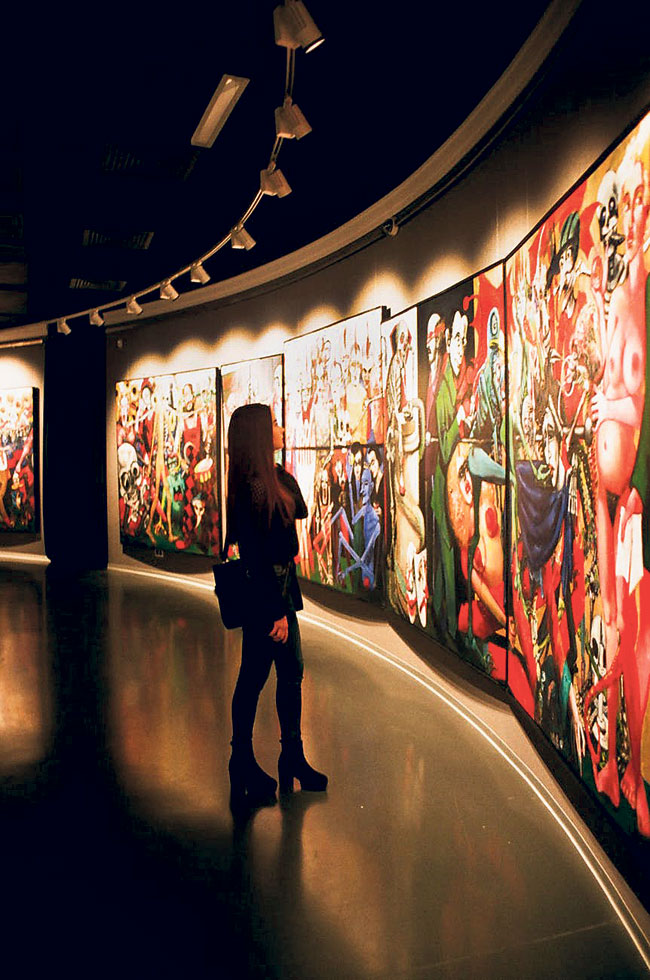
OR
A beginner’s guide to art appreciation
Published On: January 18, 2019 08:50 AM NPT By: The Week Bureau

When the news that a picture of an Irish potato sold for more than a million dollars made headlines, most of us couldn’t understand what made it so special. It’s not rare to hear people saying, “My four-year-old can draw that” while standing in front of an abstract painting or an experimental display. So, how do you know if something is worth considering art? And why do people regard paintings of seemingly nothing but colorful blotches and geometrical shapes as something legendary? If you are tired of pretending to like a piece of art without actually getting it, here is a guide for you to better your understanding.
What is art?
There are several different forms of art. Expressionist art is art that visualizes internal psychology and emotions through colors and gestures. They were started by the avant-garde artists, who made radical and experimental changes in art – as previously art was mostly considered to be a drawing or painting of a landscape, a portrait of a person or an object. The most famous example is that of the painting ‘The Scream’ by Edvard Munch who was able to portray the feeling of melancholy through a face screaming in pure agony. Similarly, there is abstract art that is deliberately not supposed to make sense, mainly so that viewers can draw their own interpretations of it. There is also conceptual art, like the 1996 ‘Equivalent VII’ – a rectangle of 120 fire bricks laid out on the floor where the idea of the art is more important that its execution. All these art forms have their own significance and one has to have a little patience and do some thinking to derive the true meaning of the given art form.
 Giving the art ‘time’
Giving the art ‘time’
The exact numbers vary but studies have determined that the average time a person spends looking at a piece in a museum is between 15 to 30 seconds. This time is not even enough to properly grasp the idea wanting to be conveyed by the artist. First thing to do is “not” say that your four-year-old can draw that. If an artist has made it to having his/her own exhibition, it’s safe to assume they know what they are doing. Just take a good look at what is happening – is it oil, pastel or tempera? How are the colors flowing? Read the wall text and also do a little research before going into the exhibition about the artist and his/her previous works and you have already done so much more than half of the people coming to see it.
Stop trying to get it
As humans, we love cracking codes and deciphering meaning but when it comes to expressionism or abstract art, forcing a meaning to it is like pouring water on sand. If it makes no sense to you and you don’t seem to enjoy looking at it, maybe it isn’t your cup of tea. There is no guarantee that the artist will tell you exactly what it’s about, so it’s perfectly okay to give it your own personal perspective. After looking at a painting or a sculpture for a while, whatever pops into your mind is exactly what you think about the piece of art and leave it at that and move on to the next exhibit.
Don’t be afraid to like/dislike something
It’s always better if you look at exhibits alone (at least for the first time). That way you won’t be influenced by your friends or anyone’s opinions and take that as the fact. We all feel different emotions when we look at a painting or an installation and we must ask ourselves “Why do we feel this way?” This is important because it helps us understand ourselves and our emotions. However, also feel free to like a piece of art and have no absolute reason why. Most of us start critiquing a piece of art (mainly classic and famed art pieces) mixing it with our personal opinions without having any prior knowledge about the art’s history, it’s evolution or story and this is where it goes all wrong. To be critical of Picasso’s work, one must be aware of his painting styles, his different periods of paintings as well as a brief knowledge of how art is compared and studied. But to like or dislike his paintings as an individual is completely one’s choice.
Consider more things art
Picasso once said, “It took me four years to paint like Raphael, but a lifetime to paint like a child.” So you see how the concept of art is so vague? All one needs is courage to put something out there and have belief in it and that it too is worth being looked at, talked about, and appreciated. Art is anything that has the power to create or change the emotion of a human being and if a single leaf blowing in the wind makes you feel so, that too is art. And after a while, who knows, maybe a shot of that very leaf taken by your old phone will be sold for another million dollars?
You May Like This

Alfesco Open Art Exhibition begins at Nepal Art Council
KATHMANDU, Feb 14: Alfresco Media and Event organized ‘Alfresco Open Art Exhibition and Competition 2017’ for pre-primary level to college level... Read More...

The art of making a perfect Coffee
Coffee is not just a beverage; it is a trend and an indication of one’s social life. Lately, coffee has... Read More...

Traditional art and culture of Karnali region on the verge of disappearance
JUMLA, Feb 17: With the modern means of culture and art sweeping the globe, the traditional culture and art of... Read More...





Just In
- World Malaria Day: Foreign returnees more susceptible to the vector-borne disease
- MoEST seeks EC’s help in identifying teachers linked to political parties
- 70 community and national forests affected by fire in Parbat till Wednesday
- NEPSE loses 3.24 points, while daily turnover inclines to Rs 2.36 billion
- Pak Embassy awards scholarships to 180 Nepali students
- President Paudel approves mobilization of army personnel for by-elections security
- Bhajang and Ilam by-elections: 69 polling stations classified as ‘highly sensitive’
- Karnali CM Kandel secures vote of confidence














Leave A Comment